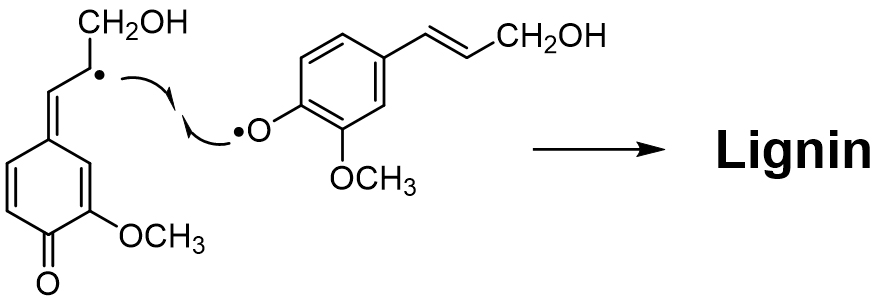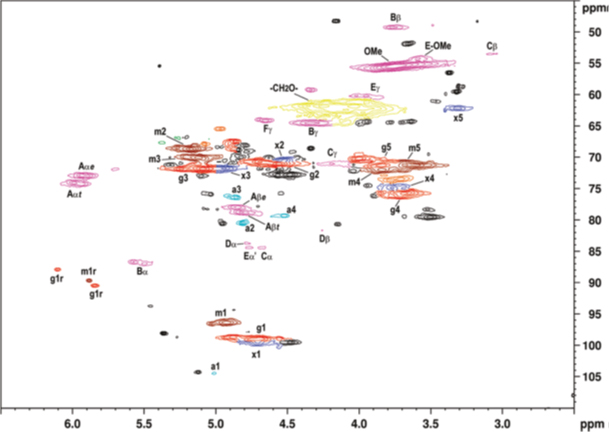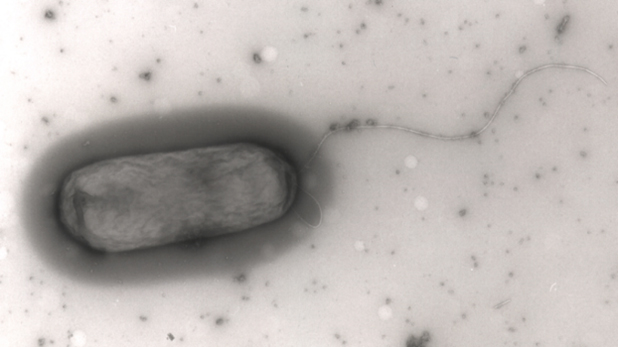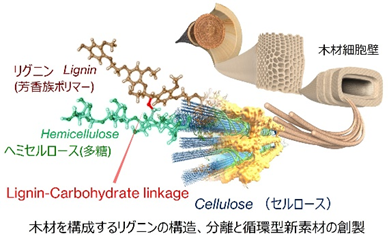Research
リグニンの重合機構と化学構造の解明
Elucidation of polymerization mechanism and chemical structure of lignin
胞壁を固める成分であるリグニンは、地球上で2番目に多い天然高分子ですが、モノマーの配列など化学構造の詳細は未解明のままであり、有効利用が遅れています。リグニンの利用にはその構造への深い理解が欠かせません。人工的にリグニンのモノマーを重合させ、リグニンの重合メカニズムや、配列を含めた詳細な化学構造の解明に取り組んでいます。
Lignin, a component that solidifies cell walls, is the second most abundant natural polymer on earth, but the detailed chemical structure remains unresolved, and its effective utilization has lagged. A deep understanding of its structure is essential for the utilization of lignin. We work on elucidating the polymerization mechanism of lignin and its detailed chemical structure, including the sequence of its monomers, by artificially polymerizing lignin monomers.

Radical coupling of lignin monomer
イオン液体を用いた細胞壁成分(セルロース・ヘミセルロース・リグニン)のHSQC NMR解析
HSQC NMR analysis of cell wall components (cellulose, hemicellulose, and lignin) using ionic liquids
ボールミルで微粉砕化した木粉を、細胞壁成分(セルロース、ヘミセルロース、リグニン)の大きな構造変化を伴わずに温和な条件下でイオン液体/共溶媒系に溶解できることを見出し、HSQC NMRスペクトルを用いた細胞壁の全成分の解析法として確立しています。この方法を、ケナフやタケ、トウモロコシなどにも応用しながら、リグニンの化学構造の解明に取り組んでいます。
Ball-milled wood can be dissolved in an ionic liquid/co-solvent system under mild conditions without major structural changes in the cell wall components (cellulose, hemicellulose, and lignin). We have established the method for the HSQC NMR analysis of all cell wall components using the ionic liquid/co-solvent system. We apply this method to other herbaceous plants, kenaf, bamboo, and maize to elucidate the chemical structure of lignin.

HSQC NMR spectrum of acetylated fir wood regenerated from ionic liquid
人工リグニンポリマーの合成
Synthesis of artificial lignin polymer
リグニンの主要構造であるβ-O-4構造のみでできた人工リグニンポリマーの合成に成功しました。この人工リグニンポリマーを、HSQC NMRスペクトルやマススペクトルによるリグニンの構造解析の際の標品として用いています。また、様々なリグニン分解法やリグニン分離法の際のリグニンの化学構造変化の解析にも用いることができます。
We have succeeded in synthesizing an artificial lignin polymer composed solely of the β-O-4 structure, the most abundant substructure of lignin. This artificial lignin polymer is used as an authentic sample for structural analysis of lignin by HSQCNMR spectra and mass spectra. It can also be used to analyze the chemical structural changes of lignin during various lignin degradation and lignin separation procedures.

β-O-4 type artificial lignin polymer
環境汚染の修復を目指した微生物の利用
Utilization of microorganisms for environmental pollution remediation
自然界に元々存在しなかった化合物や化石資源由来のプラスチック等は速やかに生分解されず,深刻な環境汚染を引き起こします.このような分解しにくい化合物を土壌細菌や木材を分解するキノコ等を用いて効率良く分解させるための研究に取り組んでいます.特に,難分解性の芳香族化合物を分解する細菌や木材成分の一つであるリグニンを分解する白色腐朽菌の遺伝・生化学的研究を行い,それらの研究成果を微生物による環境浄化(バイオレメディエーション)技術の開発の一助にすることを目指しています。
Compounds that did not originally exist in nature, such as synthetic chemicals and fossil-based plastics, do not readily undergo biodegradation, leading to severe environmental pollution. Our research focuses on efficiently decomposing such persistent compounds using soil bacteria and wood-degrading fungi. In particular, we conduct genetic and biochemical studies on bacteria that degrade recalcitrant aromatic compounds and white-rot fungi that break down lignin, a major component of wood. Through these studies, we aim to contribute to the development of bioremediation technologies that utilize microorganisms for environmental purification.

Bacteria degrading the environmental pollutant PCB (polychlorinated biphenyls)
循環型社会を目指したリグニン研究と新素材創製
Lignin research and creation of new materials for a recycling-oriented society
木質バイオマスの主要成分であるリグニンおよびリグニンと多糖の結合構造をNMRやMS、様々な分析手法を駆使して解析しています。リグニンは堅固で不定形の複雑な構造を持つ天然ポリマーです。分子構造を理解することで、優れた特性を活用して次世代新素材を開発する研究を進めています。私たちは、環境調和型バイオマス変換技術や、リグニンの生分解機構を研究し、バイオマスを基盤とした循環型社会の実現を目指しています。
We analyze lignin, a major component of woody biomass, and the bonding structure of lignin and polysaccharides using NMR, MS, and various analytical methods. Lignin is a natural polymer with a rigid, irregular, and complex structure. By understanding its molecular structure, we conduct research to develop new materials for the next generation by taking advantage of its excellent properties. We investigate environmentally friendly biomass conversion technologies and the biodegradation mechanisms of lignin, to realize a recycling-oriented society based on biomass.

